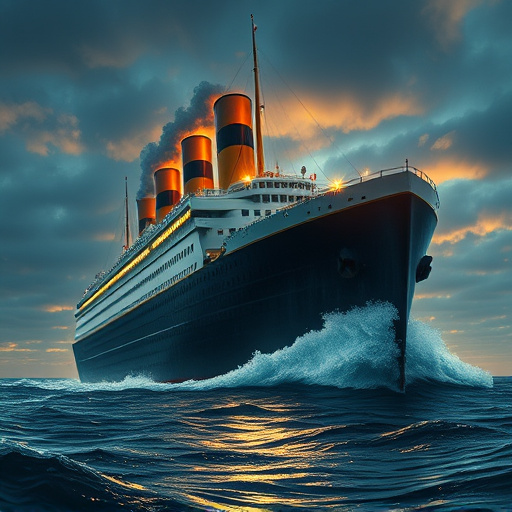The Titanic, a legend in maritime history, captivated the world with its grandeur and tragic fate. This article explores the captivating story of the ship that ‘couldn’t sink’. From its construction and launch against a backdrop of industrial might to its ill-fated voyage, we delve into the events leading up to one of the most infamous naval disasters. We also examine the lasting impact on maritime safety and cultural memory, as the Titanic remains an enduring symbol in our collective consciousness.
The Historical Context of the Titanic's Construction and Launch
The construction of the Titanic began in 1909, a time marked by unprecedented global connectivity and rapid technological advancements. This era saw a maritime race as nations vied for dominance, pushing the boundaries of engineering to create larger, faster ships capable of traversing the world’s oceans with greater efficiency. The Titanic was a symbol of this ambition, designed by Harland & Wolff in Belfast, Northern Ireland, and built to be the largest and most luxurious ship ever constructed. Its construction involved over 3,000 workers, who meticulously crafted the vessel using cutting-edge techniques and materials.
The launch of the Titanic on April 10, 1912, was a grand affair, attended by dignitaries and the curious. As she glided into the water, the ship represented not only a marvel of engineering but also a reflection of societal aspirations and fears. Just months later, the Titanic‘s tragic sinking on her maiden voyage would forever etch its name in history books, capturing the world’s imagination and leading to significant changes in maritime safety regulations.
The Fateful Voyage: The Sinking of the Titanic
The Titanic, a grand ocean liner often described as unsinkable, embarked on its maiden voyage in April 1912, carrying dreams and hopes across the Atlantic. This fateful journey, however, ended in tragedy when the ship struck an iceberg, leading to one of history’s most infamous maritime disasters. The event, which occurred in the cold waters of the North Atlantic, claimed over 1500 lives, leaving a lasting impact on global consciousness.
On that fatal night, the Titanic‘s speed and lack of sufficient lifeboats proved disastrous. Despite warnings, the ship continued at full steam, resulting in a collision that ripped open its hull. As water poured in, the once-proud vessel sank, taking with it passengers from all walks of life. The story of the Titanic serves as a stark reminder of humanity’s vulnerability against nature’s might and the ever-present need for preparedness and caution at sea.
Legacy and Memorialization: Titanic's Impact on Maritime Safety and Culture
The Titanic has left an indelible mark on maritime history, its legacy extending far beyond the tragic tale of its sinking. The disaster sparked a significant shift in maritime safety regulations and cultural perceptions. In response to the overwhelming loss of life, new standards for ship design, emergency procedures, and passenger safety were implemented globally. This led to the establishment of organizations like the International Maritime Organization (IMO), ensuring that such tragedies would never be repeated.
Today, Titanic serves as a permanent reminder of humanity’s resilience in the face of adversity and the importance of preparedness. Memorials and museums dedicated to the ship attract visitors worldwide, preserving the stories of those who perished and honoring their memory. The disaster’s cultural impact has also inspired countless works of art, literature, and film, ensuring that Titanic remains a timeless symbol of both tragedy and hope in popular culture.
